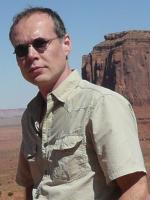
Career
- 2012-date: Lecturer, DAMTP, University of Cambridge
- 2010-2012: Ramon y Cajal Researcher, Institute of Space Sciences, CSIC-IEEC Barcelona
- 2008-2010: Senior Postdoc, Division of Physics, Maths and Astronomy, California Institute of Technology
- 2005-2008: Postdoc, Theoretical Physics Institute, University of Jena
- 2002-2005: Postdoc, Center for Gravitational Wave Physics, Penn State University
- 2001-2002: Postdoc, Department of Physics, Aristotle University of Thessaloniki
- 1998-2001: PhD, School of Mathematics, University of Southampton
Research
Ulrich Sperhake is a member of the Department of Applied Mathematics and Theoretical Physics General Relativity research group. His current research interests are Numerical Relativity, Black Holes as sources of Gravitational Waves, High-Energy Collisions of Black Holes.
Selected Publications
- M.Kesden, D.Gerosa, R.O'Shaughnessy, E.Berti, U.Sperhake, "Effective potentials and morphological transitions for binary black-hole spin precession", Phys. Rev. Lett. 114 (2015) 081103
- U.Sperhake, E.Berti, V.Cardoso and F.Pretorius, "Universality, maximum radiation and absorption in high-energy collisions of black holes with spin", Phys. Rev. Lett. 106 (2011) 161103
- C.D.Ott, C.Reisswig, E.Schnetter, E.O'Connor, U.Sperhake, F.Loeffler, P.Diener, E.Abdikamalov, I.Hawke and A.Burrows, "Dynamics and Gravitational Wave Signature of Collapsar Formation", Phys. Rev. Lett. 106 (2011) 161103
- M.Zilhao, H.Witek, U.Sperhake, V.Cardoso, L.Gualtieri, C.Herdeiro and A.Nerozzi, "Numerical relativity for D dimensional axially symmetric space-times: formalism and code tests", Phys. Rev. D 81 (2010) 084052
- U.Sperhake, V.Cardoso, F.Pretorius, E.Berti, T.Hinderer and N. Yunes, "Cross section, final spin and zoom-whirl behavior in high-energy black hole collisions", Phys. Rev. Lett. 103 (2009) 131102
- B.Aylott et al., "Testing gravitational-wave searches with numerical relativity waveforms: Results from the first Numerical INJection Analysis (NINJA) project", Class. Quantum Grav. 26 (2009) 165008
- U.Sperhake, V.Cardoso, F.Pretorius, E.Berti and J.A.Gonzalez, "The high-energy collision of two black holes", Phys. Rev. Lett. 101 (2008) 161101
- P.Ajith et al., "A Template bank for gravitational waveforms from coalescing binary black holes. I. Non-spinning binaries", Phys. Rev. D 77 (2008) 104017
- J.A.Gonzalez, M.D.Hannam, U.Sperhake, B.Bruegmann and S.Husa, "Supermassive kicks for spinning black holes", Phys. Rev. Lett. 98 (2007) 231101
- J.A.Gonzalez, U.Sperhake, B.Bruegmann, M.D.Hannam and S.Husa, "The maximum kick from nonspinning black-hole binary inspiral", Phys. Rev. Lett. 98 (2007) 091101
- E.Berti, V.Cardoso, J.A. Gonzalez, U.Sperhake, M.Hannam, S.Husa and B.Bruegmann, "Inspiral, merger and ringdown of unequal mass black hole binaries: A multipolar analysis", Phys. Rev. D 76 (2007) 064034
- U.Sperhake, "Binary black-hole evolutions of excision and puncture data", Phys. Rev. D 76 (2007) 104015
Publications
Waveform modelling for the Laser Interferometer Space Antenna
– Living Reviews in Relativity
(2025)
28,
9
(doi: 10.1007/s41114-025-00056-1)
Long-Term Stable Nonlinear Evolutions of Ultracompact Black-Hole Mimickers.
– Physical Review Letters
(2025)
135,
131402
(doi: 10.1103/lk48-7r2f)
Long-term stable nonlinear evolutions of ultracompact black-hole
mimickers
(2025)
Hair is complicated: Gravitational waves from stable and unstable
boson-star mergers
(2024)
Gravitational-Wave Data Analysis with High-Precision Numerical Relativity Simulations of Boson Star Mergers.
– Physical Review Letters
(2024)
133,
131401
Gravitational-Wave Data Analysis with High-Precision Numerical
Relativity Simulations of Boson Star mergers
(2024)
Boson stars in massless and massive scalar-tensor gravity
– Physical Review D
(2023)
108,
104064
(doi: 10.1103/PhysRevD.108.104064)
Stochastic gravitational wave background from supernovae in massive scalar-tensor gravity
– Physical Review D
(2023)
107,
124040
(doi: 10.1103/PhysRevD.107.124040)
Unequal-mass boson-star binaries: initial data and merger dynamics
– Classical and Quantum Gravity
(2023)
40,
085009
(doi: 10.1088/1361-6382/acc2a8)
- 1 of 16
